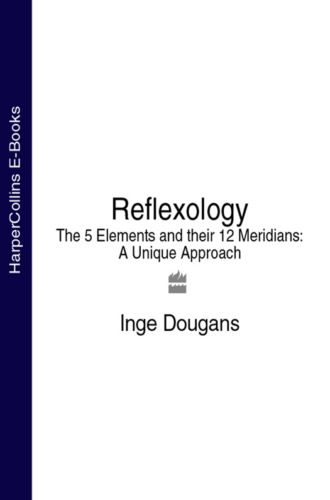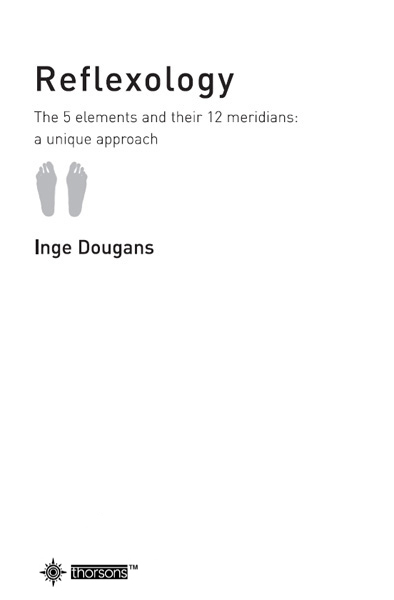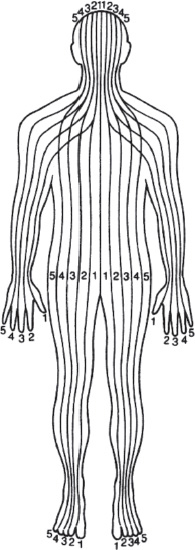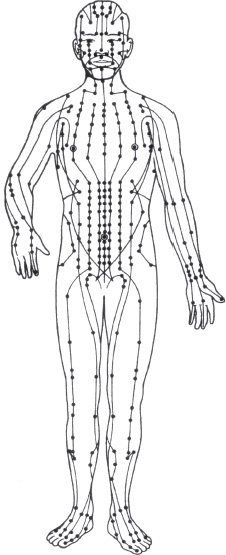
Полная версия
Reflexology: The 5 Elements and their 12 Meridians: A Unique Approach


dedication
This book is dedicated to my two sons, Daniel and Thomas, who wholeheartedly believe and support me – you are my yin/yang balance in my life; and also to Wolf-Rudiger, who for years has been the ‘spark’ that keeps my fire element strong.
contents
Cover
Title here
Dedication
Introduction
1 The Foundation of Modern Reflexology
2 The Principles of Chinese Medicine
3 Applying a Knowledge of the Meridians in Reflexology
4 The 5 Elements and their 12 Meridians
5 Mapping the Feet
6 Anatomy, Structure and Conditions of the Feet
7 The Treatment Sequence
Appendix: The Vacuflex System
References
Bibliography
Acknowledgements
Copyright
About the Publisher
introduction
Over the last two decades, reflexology has become an established form of natural healing that is now gaining wide acceptance in the Western world. Yet reflexology has grown out of a much older system: traditional Chinese Medicine (TCM).
The practice of TCM, including acupuncture, goes back several thousand years. Since that time it has been well preserved and continuously developed. TCM is characterized by its specific diagnostic techniques and therapeutic principles based on a practitioner’s interpretation of the physiological functions and pathological changes in the human body.
Reflexology also works on pressure points to stimulate the body’s own healing potential, but mainly in the feet and with specific massage techniques. Even though reflexology has its roots in ancient Eastern forms of healing, the development of modern reflexology has happened primarily in the West. When reflexology first emerged in the West, the traditional Chinese energy pathways, or meridians, and the associated pressure points in the body were not common knowledge. As a result, reflexologists independently developed their interpretations of energy zones in the body and corresponding pressure points. The ten reflexology zones are helpful, but we can gain a greater understanding of the energy pathways in the body if we look to TCM.
I have been practising and teaching reflexology for over 25 years. These years of experience have made it clear to me that elements of traditional Chinese Medicine can – and indeed should – play a vital role in the effective practice of reflexology. For example, when you work with a patient to assess the root cause of an ailment or condition, the Chinese meridian system is more accurate than the ten reflexology zones. It is time for reflexology to revisit its Eastern roots and draw vital lessons from its ancient heritage to enhance its practice.
There is another essential part of reflexology training I advocate that is not a part of traditional reflexology training: diet. Reflexology, like many of the natural healing therapies available today, cannot be successfully applied without also considering how the body is nourished. What we eat has a profound impact on the general environment of the body and also affects how well it can respond to healing treatments. If a person has poor eating habits it will make congestions and diseases denser and more difficult for the body to eliminate. This is why you must also look at a person’s diet as part of their overall treatment, in particular their blood sugar and acid-alkaline balance, since a body that is too acid is more vulnerable to disease and injury. If you take steps to establish a healthy environment in the body it is much easier to reverse and prevent illness.
I have been teaching and practising this new integrated approach to reflexology, combining TCM and diet, for many years. Indeed, my school of reflexology, The International School of Reflexology, has campuses around the world and this approach is taught at every one and with great success. Time and time again, people tell me how an understanding of TCM and diet has made them more effective reflexologists.
It is now time to make this knowledge and understanding more widely available and this is what I have set out to achieve with this book: Chapter 1 takes a look at the history of reflexology and how it developed into what we know today; Chapters 2 and 3 introduce the principles of Chinese Medicine and show how they can be applied to reflexology to facilitate more effective healing; Chapter 4 takes a close look at the traditional Chinese systems of the 5 Elements and their 12 meridians from a Western perspective and interprets the traditional characteristics of fire, earth, metal, water and wood for the modern world; Chapter 5 maps the reflexes on the feet; Chapter 6 studies the anatomy, structure and various conditions of the feet; and Chapter 7 shows how to put it all together and give a full reflexology treatment.
It is my hope that this book will make a strong contribution to the understanding of reflexology and that this integrated approach will bring enormous benefits, in terms of health and healing, to practitioners and patients throughout the world.
I wish you good health and the joy of always feeling fit and full of energy.
Inge Dougans
chapter 1
the foundation of modern reflexology
The European Influence
In Europe, a form of reflexology was known and practised as far back as the 14th century. According to Harry Bond Bressler in his book Zone Therapy, pressure therapy was well known in central Europe and was practised by the working classes of those countries as well as by those who catered to the diseases of royalty and the upper classes. Dr Adamus and Dr A’tatis wrote a book on the subject of zone therapy, which was published in 1582; another book on the subject by Dr Ball was published soon after in Leipzig.1
The scientific basis of reflex study had its roots in neurological studies conducted in the 1890s by Sir Henry Head of London. In 1898, he discovered zones on the skin which became hypersensitive to pressure when an organ connected by nerves to this skin region was diseased. After years of clinical research, Head established what became known as ‘Head’s Zones’ or ‘zones of hyperalgesia.’
Russian work on reflexes began from a psychological point of view. The founder of Russian physiology, Ivan Sechenov (who discovered the cerebral inhibition of spinal reflexes), published a paper in 1870 titled ‘Who Must Investigate the Problems of Psychology and How?’ Psychologists under Vladimir Bekhterev, founder of Leningrad’s Brain Institute, picked up the challenge and studied it through reflexes. At the same time, Ivan Pavlov (1849–1936) read Sechenov’s work and acknowledged that his book Reflexes of the Brain was the most important theoretical inspiration for his own work on conditioning. Pavlov took Sechenov’s theoretical outline and submitted it to methodical experimental study. Through this, Pavlov developed the theory of conditioned reflexes – namely that there is a simple and direct relationship between a stimulus and a response. Pavlov found that practically any stimulus could act as a conditioning stimulus to produce a conditioned response.2
Today the Russians continue to pursue the study of reflexology, both from the physiological and psychological point of view. They have scientifically tested the effect of reflex therapy on patients with a variety of problems and have found reflexology to be an effective complement to traditional medicine.3
At the same time, the Germans were also looking into the treatment of disease by massage. In the late 1890s and early 1900s, massage techniques developed in Germany became known as ‘reflex massage.’ This was the first time that the benefits of massage techniques were credited to reflex actions.
It is possible that Dr Alfons Cornelius was the first to apply massage to ‘reflex zones.’ The story goes that in 1893 Cornelius suffered from an infection and in the course of his convalescence he received a daily massage. While at the spa he noticed how effective the massages of one particular medical officer were. This man worked longer on areas he found to be painful. This concept inspired Cornelius. After examining himself, Cornelius instructed his masseur to work only on the painful areas. His pain quickly disappeared and in four weeks he recovered completely. This led him to pursue the use of pressure in his own medical practice. He published his manuscript Druckpunkte (or ‘Pressure Points, The Origin and Significance’) in 1902.4 Europeans went on to expand on the existing research but credit for putting modern reflexology on the map must go to the Americans.
The American Influence
Dr William Fitzgerald, commonly held as the founder of zone therapy, was born in Connecticut, USA, in 1872. He graduated in medicine from the University of Vermont in 1895 and practised in hospitals in Vienna and London. In Vienna, he came into contact with the work of Dr H Bressler, who had been investigating the possibility of treating organs with pressure points. Fitzgerald continued his research while Head Physician at the Hospital for Diseases of the Ear, Nose and Throat in Hartford, Connecticut, testing out many of his theories on his patients. Through knowledge he gained in Europe and his own research, Fitzgerald found that if pressure was applied to the fingers, it would create a local anaesthetic effect on the hand, arm and shoulder, right up to the jaw, face, ear and nose. He applied pressure using tight bands of elastic on the middle section of each finger or small clamps placed on the fingertips. He was able to carry out minor surgical operations using this pressure technique.5
Dr Fitzgerald divided the body into zones, which he used for his anaesthetic effect. By exerting pressure on a specific part of the body he learned to predict which other parts of the body would be affected. Fitzgerald established 10 equal longitudinal zones running the length of the body from the top of the head to the tips of the toes. The number 10 corresponds to the fingers and toes and therefore provides a simple numbering system. Each finger and toe falls into one zone. Imagine a line drawn through the centre of the body with 5 zones on either side of this line. The thumb and big toe fall into zone 1 and the small finger and toe both fall into zone 5. The zones are of equal width and extend right through the body from front to back. The theory is that parts of the body found within a certain zone are linked with one another by the energy flow within the zone and can therefore affect one another.

Fig. 1 The Zones
In his book Zone Therapy, Fitzgerald describes how he came upon the concept of zone therapy:
‘I accidentally discovered that pressure with a cotton-tipped probe on the mucocutaneous margin (where the skin joins the mucous membrane) of the nose gave an anaesthetic result as though a cocaine solution had been applied. I further found that there were many spots in the nose, mouth, throat, and on both surfaces of the tongue which, when pressed firmly, deadened definite areas of sensation. Also, those pressures exerted over any body eminence, on the hands, feet, or over the joints, produced the same characteristic results in pain relief. I found also that when pain was relieved, the condition that produced the pain was most generally relieved. This led to my “mapping out” these various areas and their associated connections, and also to noting the conditions influenced through them. This science I have named zone therapy.’ 6
Fitzgerald and his colleague Dr Edwin Bowers were so enthusiastic about their discoveries that they developed a unique method for convincing their colleagues about the validity of zone theory. They would apply pressure to the sceptic’s hand then stick a pin in the area of the face anaesthetized by the pressure. Such dramatic proof made believers of those who witnessed it. In 1915, Bowers wrote the article that first publicly described this treatment and called it ‘zone therapy.’ Published in Everybody’s Magazine, it was entitled ‘To Stop That Toothache Squeeze Your Toe!’7
The article elicited much interest and controversy, and Fitzgerald was often called upon to prove publicly the validity of his theories. One such incident was reported in a newspaper on April 29, 1934, under the headline ‘Mystery of Zone Therapy Explained.’ The article tells of a dinner party at which one of the guests was Fitzgerald and another was a well-known concert singer who had announced that the upper register tones of her voice had gone flat. The article noted that throat specialists had been unable to discover the cause of this affliction. Dr Fitzgerald, according to the article, asked to examine the fingers and toes of the singer. After his examination, he told her that the cause of the loss of her upper tones was a callus on her right big toe. After applying pressure to the corresponding part in the same zone for a few minutes, the patient remarked that the pain in her toe had disappeared. Then, to quote from the article: ‘The doctor asked her to try the tone of the upper register. Miraculously, it would seem to us, the singer reached two tones higher than she had ever done before.’8
In 1911, the combined work of Dr Fitzgerald and Dr Bowers was published in Zone Therapy. Diagrams of the zones of the feet and the corresponding division of the 10 zones of the body appeared in the first edition of this book. But Fitzgerald did not single out the reflex zones of the feet, so crucial to modern reflexology, for any special attention.
While the medical profession did not receive Fitzgerald and his theories enthusiastically, one physician did believe in his work – Dr Joseph Shel – by Riley. Fitzgerald taught zone therapy to Riley and Riley’s wife Elizabeth, and they used the method in their medical practice for many years. Riley refined the techniques and made the first detailed diagrams and drawings of the reflex points located in the feet. He added to Fitzgerald’s longitudinal zones his discovery of eight horizontal divisions, which also govern the body. His first book, Zone Therapy Simplified, was published in 1919. He went on to write four books in which large portions were devoted to zone therapy.9
Fitzgerald, Bower and Riley developed and refined the theory to zone therapy, but it was Riley’s assistant Eunice Ingham who probably made the greatest contribution to the establishment of modern reflexology. It was through her untiring research and dedication that reflexology finally came into its own. She separated the work on the reflexes of the feet from zone therapy in general.
Eunice Ingham (1889–1974) should be known as the Mother of Modern Reflexology. She used zone therapy in her work but felt that the feet should be specific targets for therapy because of their highly sensitive nature. She charted the feet in relation to the zones and their effects on the rest of the anatomy until she had drawn up on the feet themselves a ‘map’ of the entire body. So successful was her work that she is now recognized as the founder of foot reflexology.
Eunice Ingham took her work to the public and the non-medical community because she realized that lay people could learn the proper reflexology techniques to help themselves, their families and friends. She was called on to speak at conventions and shared her knowledge with chiropodists, massage practitioners, physiotherapists, naturopaths and osteopaths. She travelled throughout America for over 30 years as she taught her method through books, charts and seminars to thousands of people in and out of the medical profession. She wrote two books, Stories the Feet Can Tell (1938) and Stories the Feet Have Told (1963). Today her legacy continues under the direction of her nephew Dwight Byers.10
The Chinese Connection
To date, most reflexologists have worked with the theory of energy zones described by Dr Fitzgerald. Although this theory has stood reflexology in good stead and contributed greatly to the development of the modern therapy, I do not adhere to it myself. I believe the effects elicited by massaging the feet or hands are largely the result of stimulating the six meridians that run through the feet, as well as the six meridians in the hands. Fitzgerald recognized an energetic connection between the feet and hands with other parts of the body, and without his pioneering work reflexology would not be where it is today. But as the Eastern concept of the meridian system was unknown in the West at the time of his research, the connection with the meridians was not recognized. I, however, am convinced that the energy channels linking the feet and hands to other organs and body parts are the meridians described in Chinese medicine.
Zone theory is considered the basis of modern foot reflexology and most reflexologists use zone theory as a useful adjunct to their work. However, the time has come to take foot reflexology further and expand on existing knowledge by combining it with the ancient Chinese system of meridian therapy. Many believe foot reflexology had its origins in China and developed around the same time as acupuncture. Despite the fact that no definite links can be made, a combination of what is now regarded as primarily a Western development with an ancient Eastern treatment can only be beneficial.
There can be little doubt that a strong link exists between reflexology and acupuncture. They are certainly based on similar ideas. Both are considered meridian therapies as they propose that energy links the hands and feet to various body parts. This enables the whole body to be treated by working on the reflex areas. Acupuncture went from strength to strength in the East but reflexology was, for some reason, lost and forgotten until its recent re-emergence in the West.
The Chinese had divided the body into longitudinal meridians by approximately 2500 BC, whereas the similar idea of zones came to Western awareness as late as the 1900s. Acupuncture, despite its popularity in the East, was an unknown art in the West until 1883, when Dutch physician Ten Thyne wrote a treatise on the subject.
According to acupuncture, the body has 12 pairs of meridians, as well as 2 special meridians known as vessels. Together these constitute the body’s energy system, which works to maintain the health of the organism. These meridians are pathways through which the energy of the universe circulates throughout the body organs and keeps the universe and the body in harmony. The acupuncturist believes that illness or pain manifest when the pathways become blocked, disrupting the energy flow and breaking the body’s harmony. In acupuncture, the Chinese developed the use of needles to unblock these pathways. In Shiatsu, the Japanese use direct thumb and finger pressure on acupuncture meridian points to achieve similar results.11 Reflexologists also work on acupuncture and acupressure points but only those found in the feet and hands. Through increased awareness of meridians, reflexology can be practised more effectively, as meridians provide profound insight into the disease pathway, and are therefore a most useful assessment tool.

Fig. 2 The meridians
The Chinese were undoubtedly aware of the importance of the feet in treating disease. In AD 1017, Dr Wang Wei had a human figure cast in bronze on which were marked those points on the body important for acupuncture. Practitioners put this knowledge into practice in treating the sick, by positioning the needles in the appropriate areas of the body and then applying deep pressure therapy on the soles of the inside and outside edges of both feet. They then applied a concentrated pressure on the big toe. The reason they used the feet in conjunction with the acupuncture needles was to channel extra energy through the body. Dr Wei said that the feet were the most sensitive part of all and contained great energizing areas.12
It is not my purpose here to prove that reflexology is directly related to the meridians. The object is to illustrate that a combination of knowledge – modern reflexology techniques and the Eastern meridian system – can be of enormous benefit both to patient and practitioner. As acupuncture and reflexology are concerned with balancing energy flow in order to stimulate the body’s own healing potential and restore the state of health, and both are concerned with treating illness in a holistic manner, it seems logical to combine reflexology with meridian therapy in order to provide a more comprehensive and effective treatment programme.
Zones versus Meridians
I am unable to agree with the majority of reflexologists who accept the concept of body congestions being reflected in the longitudinal zones described by Fitzgerald, and am unaware of any definite proof supporting zone theory. I believe reflexology originally developed in conjunction with acupuncture. The reason for massaging the foot was primarily to stimulate the six main meridians that run through the feet. During the course of history, the relationship between these two practices was somehow lost and forgotten. When reflexology re-emerged in the West, researchers and practitioners came to the conclusion that stimulating the feet caused a reaction in the body, but were not sure how this was actuated. As the Eastern meridian knowledge had not at that stage arrived in the West, the relationship with the meridians was not realized, so zone theory was born.
In fact, there are parallels between the meridians and zones. Take, for example, the relationship between the eyes and the kidneys. In zone theory, problems with the eyes can be related to kidney disorders as they both fall into zone 2. This relationship also occurs in the meridians. The bladder meridian begins at the eyes, as does the stomach meridian. The stomach meridian penetrates the kidneys and imbalances may manifest as dark shadows or puffiness under the eyes. Orthodox medicine, too, accepts these signs as being indicative of kidney disorders. The stomach meridian ends in the second toe, with an internal branch of the same meridian in the third toe. Here we have the connection with the toes – the second and third toes represent the eye reflexes and the stomach meridian.
Meridians and Reflexology
The concept of energy channels is the central point around which the practices of reflexology and acupuncture are based. Both function on the premise that vital energy is channelled through the body along specific pathways. In acupuncture, these energy lines are the meridians. In reflexology, as has been perceived to date, the energy channels are those of the zones popularized by Dr W Fitzgerald.
Both practices assert that disease is caused by blockages in energy channels. The acupuncture points, situated all over the body, are usually stimulated or sedated with needles. Reflexology concentrates mainly on the feet, but can also work on the hands, ears or other parts of the body, stimulating with specific finger pressure techniques the reflex areas as well as the sections of meridians situated here.
The six main meridians – those that penetrate the major body organs – are represented in the feet, specifically in the toes. Thus stimulation of the feet helps clear congestions in the meridians. Meridian theory assumes that a disorder within a meridian generates derangement in the pathway and creates disharmony along that meridian, or that such derangement is a result of a disharmony of the meridian’s connecting organ. Knowledge of meridians can help reflexologists to understand the disease pathway more comprehensively. A basic knowledge of meridians can be of enormous benefit in pinpointing problem areas. If, for example, pain or irritation does not improve satisfactorily through treatment of the reflex area, one should observe the meridian, which traverses the part of the body in question, and treat the reflex area of the organ related to that particular meridian.




